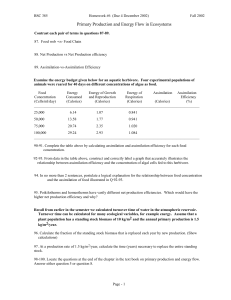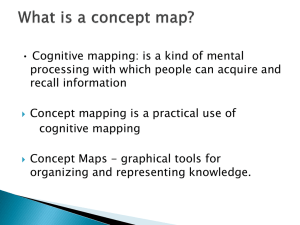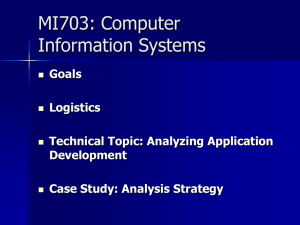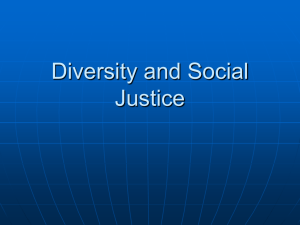A STUDY ON DATA ASSIMILATION OF PEOPLE FLOW
advertisement
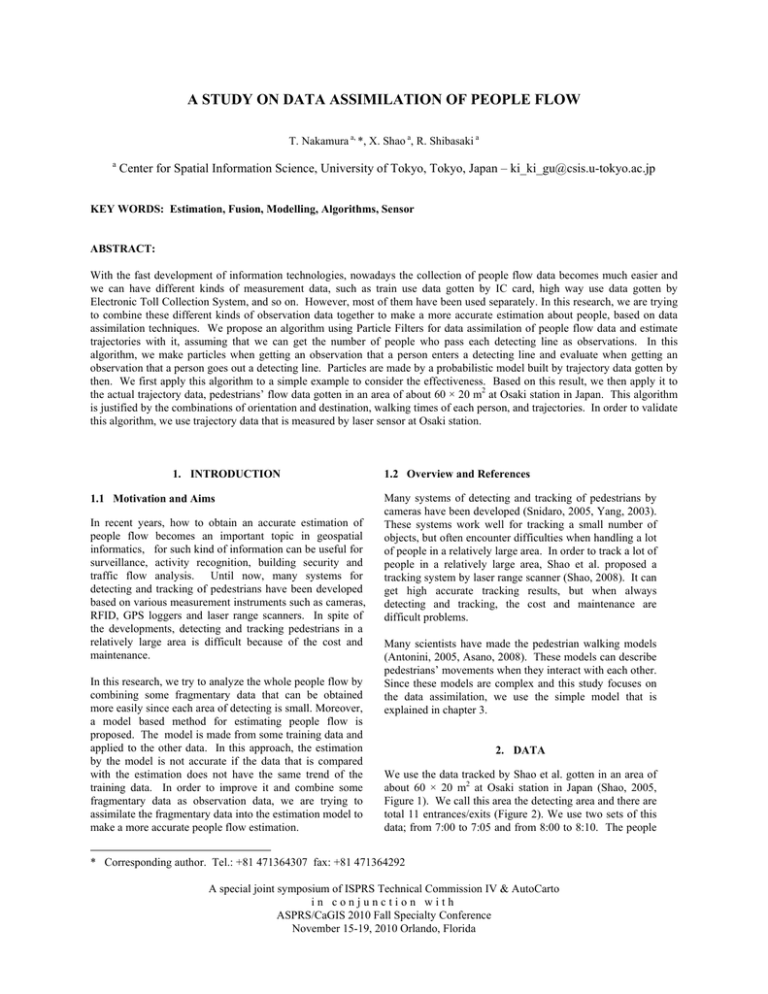
A STUDY ON DATA ASSIMILATION OF PEOPLE FLOW T. Nakamura a, *, X. Shao a, R. Shibasaki a a Center for Spatial Information Science, University of Tokyo, Tokyo, Japan – ki_ki_gu@csis.u-tokyo.ac.jp KEY WORDS: Estimation, Fusion, Modelling, Algorithms, Sensor ABSTRACT: With the fast development of information technologies, nowadays the collection of people flow data becomes much easier and we can have different kinds of measurement data, such as train use data gotten by IC card, high way use data gotten by Electronic Toll Collection System, and so on. However, most of them have been used separately. In this research, we are trying to combine these different kinds of observation data together to make a more accurate estimation about people, based on data assimilation techniques. We propose an algorithm using Particle Filters for data assimilation of people flow data and estimate trajectories with it, assuming that we can get the number of people who pass each detecting line as observations. In this algorithm, we make particles when getting an observation that a person enters a detecting line and evaluate when getting an observation that a person goes out a detecting line. Particles are made by a probabilistic model built by trajectory data gotten by then. We first apply this algorithm to a simple example to consider the effectiveness. Based on this result, we then apply it to the actual trajectory data, pedestrians’ flow data gotten in an area of about 60 × 20 m2 at Osaki station in Japan. This algorithm is justified by the combinations of orientation and destination, walking times of each person, and trajectories. In order to validate this algorithm, we use trajectory data that is measured by laser sensor at Osaki station. 1. INTRODUCTION 1.1 Motivation and Aims In recent years, how to obtain an accurate estimation of people flow becomes an important topic in geospatial informatics, for such kind of information can be useful for surveillance, activity recognition, building security and traffic flow analysis. Until now, many systems for detecting and tracking of pedestrians have been developed based on various measurement instruments such as cameras, RFID, GPS loggers and laser range scanners. In spite of the developments, detecting and tracking pedestrians in a relatively large area is difficult because of the cost and maintenance. In this research, we try to analyze the whole people flow by combining some fragmentary data that can be obtained more easily since each area of detecting is small. Moreover, a model based method for estimating people flow is proposed. The model is made from some training data and applied to the other data. In this approach, the estimation by the model is not accurate if the data that is compared with the estimation does not have the same trend of the training data. In order to improve it and combine some fragmentary data as observation data, we are trying to assimilate the fragmentary data into the estimation model to make a more accurate people flow estimation. 1.2 Overview and References Many systems of detecting and tracking of pedestrians by cameras have been developed (Snidaro, 2005, Yang, 2003). These systems work well for tracking a small number of objects, but often encounter difficulties when handling a lot of people in a relatively large area. In order to track a lot of people in a relatively large area, Shao et al. proposed a tracking system by laser range scanner (Shao, 2008). It can get high accurate tracking results, but when always detecting and tracking, the cost and maintenance are difficult problems. Many scientists have made the pedestrian walking models (Antonini, 2005, Asano, 2008). These models can describe pedestrians’ movements when they interact with each other. Since these models are complex and this study focuses on the data assimilation, we use the simple model that is explained in chapter 3. 2. DATA We use the data tracked by Shao et al. gotten in an area of about 60 × 20 m2 at Osaki station in Japan (Shao, 2005, Figure 1). We call this area the detecting area and there are total 11 entrances/exits (Figure 2). We use two sets of this data; from 7:00 to 7:05 and from 8:00 to 8:10. The people * Corresponding author. Tel.: +81 471364307 fax: +81 471364292 A special joint symposium of ISPRS Technical Commission IV & AutoCarto in conjunction with ASPRS/CaGIS 2010 Fall Specialty Conference November 15-19, 2010 Orlando, Florida flow estimation model is made from the latter set and the proposed data assimilation algorithm is validated by the former set. The former data has 323 pedestrians and their trajectories and the latter data has 2299 pedestrians and their trajectories (table 1). Each trajectory updates every 50 ms and all pedestrians enter and leave the detecting area from one of 11 entrances/exits. Table 2. Distribution of the trajectories of the training data entranceID the number of trajectories entranceID the number of trajectories 1 2 3 4 5 6 108 230 383 258 93 361 7 8 9 10 11 48 11 640 25 142 3.2 Data Assimilation Algorithm Figure 1. A sample image of tracking result We propose an algorithm using Particle Filters for data assimilation of people flow data. First, we make particles by using the people flow estimation model as candidates of the estimated trajectory. Each of them has a weight that is initialized as 1/n (n is the total number of particles) when a pedestrian gets into the area. For example, if a pedestrian gets into the detecting area from entrance 1 at time t0, and 108 particles are made, then each particle is has a weight, 1/108 at time t0. We make particles for all the pedestrians getting into the area. We then update the weights of them if we get an observation data. When we get some observation n(t) at time t, weights of particles are updated by it as following. wˆ (i ) w(i ) n(t ) (1) n w( j ) j 1 Figure 2. 11 entrances/exits at Osaki Station Table 1. Specification of tracking data time the number of pedestrians test data 7:00-7:05 training data 8:00-8:10 323 2299 3. PROPOSED METHOD 3.1 People Flow Estimation Model Since we focus on the data assimilation algorithm, we use a simple people flow estimation model. First, we distribute the trajectories of the training data to each origin entrance. The entrance 1 is distributed 108 trajectories, for example, and entrance 2 is distributed 230 trajectories (Table 2). If a pedestrian get into the detecting area from entrance i, the simple estimation model gives the trajectory that is selected randomly from the distributed trajectories of entrance i. In other words, all distributed trajectories at each entrance have the same probabilities to being selected as the estimated trajectory. Here w(i) is the weight of the ith particle that is observed between time t-1 and time t. Finally, each set of weights made for the same pedestrian is normalized and the weights are regarded as the probabilities of the particles. Weights of particles may be not accurate enough and do not perfectly indicate the observation after one run of the algorithm. Therefore, we repeat the algorithm until they are converged. When they are converged, we can get the weights that perfectly reflect all observations as the probabilities of the particles. We use the following condition for the convergence of weights. wn wn 1 0.01 wn (2) Here wn is the weight of a particle at nth iteration. A special joint symposium of ISPRS Technical Commission IV & AutoCarto in conjunction with ASPRS/CaGIS 2010 Fall Specialty Conference November 15-19, 2010 Orlando, Florida is better than the one without assimilation (Table 4, Figure 4b). The observation data at exit 6 every 10 seconds makes it better. start Make particles Table 3. Average of RMSE of destinations time = start time observation yes Update weights RMSE with assimilation 36.68 Table 4. Average of RMSE of destinations at exit 6 no time++ no without assimilation 39.67 time >= finish time RMSE without assimilation 41.51 yes with assimilation 25.59 R M SE of the num ber of pedestrians normalize weights no w ith assim ilation 80 weights are converged yes finish 60 40 20 0 Figure 3. Flow chart of the data assimilation algorithm 0 20 40 60 80 w ithout assim ilation 4. EXPERIMENTAL RESULTS R M SE of the num ber of pedestrians at exit 6 4.1 Processing of the Training Data w ith assim ilation 60 At first, we analyze the reproducibility of the algorithm. We estimate the training data that is used for the estimation model and compare the estimated data that is assimilated some observation data with the estimated data that is not assimilated. We use the number of people who get out the area from each entrance every 10 seconds as observation data. The number of iterations is 50 times. We calculate RMSE of the number of pedestrians who leave the area from each destination exit and RMSE of the number of pedestrians who leave the area from exit 6 every 10 seconds to verify that the assimilated observations are reflected. The reason why we use exit 6 is that the number of pedestrians who leave the area from it is the most. Since we can get the probabilities of the particles and do not get the destinations of the pedestrians, we select the particle from the particles of each pedestrian by using their probabilities and random numbers. We select particles and calculate RMSE 100 times to remove the bias of random numbers. RMSE of the number of pedestrians who leave the area from each destination exit shows that the result of the estimation with assimilation is as almost same as the one without assimilation (Table 3, Figure 4a). Figure 4 is the dispersion of the values of RMSE that are arranged in ascending order. This is because the estimation model is made from the training data and we estimate it. RMSE of exit 6 shows that the result the estimation with assimilation 40 20 0 0 20 40 60 w ithout assim ilation (a) RMSE of destinations (b) RMSE at exit 6 Figure 4. RMSE of destinations 4.2 Validation using the Test Data In this section, we show the results of the attempts with the test data, from 7:00 to 7:05. At first, we verify the efficiency of the data assimilation algorithm by the same way of the previous section. The number of iterations is 108 times. The result shows that the estimation with assimilation is better than the one without assimilation (Table 5, Table 6, Figure 5). Table 5. Average of RMSE of destinations RMSE without assimilation 36.86 with assimilation 12.73 A special joint symposium of ISPRS Technical Commission IV & AutoCarto in conjunction with ASPRS/CaGIS 2010 Fall Specialty Conference November 15-19, 2010 Orlando, Florida Table 6. Average of RMSE of destinations at exit 6 RMSE without assimilation 14.49 with assimilation 9.14 R M SE of the num ber of pedestrians w ith assim ilation 60 Figure 6. Map of grid counts of the actual data 40 20 0 0 20 40 60 w ithout assim ilation R M SE of the num ber of pedestrians at exit 6 w ith assim ilation 20 15 (a) without assimilation (b) with assimilation 10 Figure 7. Map of grid counts 5 0 0 5 10 15 20 w ithout assim ilation (a) RMSE of destinations We then add some detecting lines on which pedestrians are observed to get more accurate trajectory estimation. At first, we attempt the following four detecting lines that we give numbers in sequence. (b) RMSE at exit 6 Figure 5. RMSE of destinations Next, we divide the area by 1m × 1m grid and calculate the number of pedestrians who pass each grid to analyze the trajectories of the estimations. Table 7 shows that the estimation with assimilation is better than the one without assimilation in RMSE of grid counts. Figure 6 and 7 show that pedestrians spread more in both the estimation with and without assimilation than in the actual data. Moreover, pedestrians spread more in Figure 7(a) than Figure 7(b), especially at the right part. This result shows that the spread of pedestrians by the proposed data assimilation algorithm. (a) detecting line 1 (b) detecting line 2 Table 7. RMSE of grid counts without assimilation RMSE 195.96 with assimilation 178.33 A special joint symposium of ISPRS Technical Commission IV & AutoCarto in conjunction with ASPRS/CaGIS 2010 Fall Specialty Conference November 15-19, 2010 Orlando, Florida As a result, the smaller time interval is better (Figure 10), but RMSE of 300-second time interval is not bad. Therefore, if the time interval is much, useful observations can alleviate the errors of the estimation. Moreover, though we can get details more if we get observations by a few seconds, the best time interval is 35 seconds, not near 5 seconds (Figure 11). This is because this estimation is for people flow, not for individuals. R M SE of grid counts Figure 8. Setting of the detecting lines We attempt four cases in which we add the number of pedestrians who pass each detecting line as observation data. As a result, Table 8 shows that line 1 and 4 are useful to make the estimation more accurate and line 2 and 3 result in no significant change. The reason why line 2 is not useful is that information on line 2 is similar to the one at entrance/exit 9, the right upper entrance/exit. because there are three entrances/exits at the right part of line 2 and the other two entrances/exits of them are used little. Line 3 is too long to make important information. Table 8. RMSE of grid counts of each detecting line RMSE no line 178.33 line 1 173.16 line 2 178.28 line 3 178.41 line 4 172.29 Since line 1 and 4 are useful, we add the number of pedestrians who pass line 1 and 4 as observation data and estimate the trajectories. As a result, RMSE of grid counts is 167.17 and this is the best case of all other cases. However, it is difficult to find some differences between Figure 9 and Figure 8(b). Therefore, line 1 and 4 can make the estimation accurate a little. R M SE (d) detecting line 4 0 100 200 300 tim e(s) Figure 10. RMSE of grid counts by time intervals from 30s to 300s R M SE of grid counts R M SE (c) detecting line 3 171 170 169 168 167 166 165 168 167 166 165 164 0 15 30 45 60 tim e(s) Figure 11. RMSE of grid counts by time intervals from 5s to 60s 5. CONCLUSIONS AND FUTURE WORKS We have proposed a model based method for estimating people flow and a data assimilation algorithm for it. By using the data assimilation algorithm, we can get the probabilities that perfectly reflect the assimilated observation data. Figure 9. Map of grid counts of the best case Finally, we analyze the time interval of the observation data. As the observation data, we use the setting of the best case and change the time interval from 30 to 300 seconds by 30 seconds and from 5 seconds to 60 seconds by 5 seconds. The result of the experiment shows that the estimation with assimilation reflects the assimilated observation data well and if we use proper observations, we can get more accurate estimation in trajectories as well. In future works, we intend to attempt many cases with various observations to analyze how we should select the observation data for the data assimilation algorithm. Moreover, getting useful observations automatically is worth trying. In addition, we intend to develop the people flow estimation model. A special joint symposium of ISPRS Technical Commission IV & AutoCarto in conjunction with ASPRS/CaGIS 2010 Fall Specialty Conference November 15-19, 2010 Orlando, Florida REFERENCES Asano, M., 2008. Dynamic Cell Transmission-Based Pedestrian Model with Multidirectional Flows and Strategic Route Choices. Transportation Research Record: Journal of the Transportation Research Board,No. 2039, pp. 42-49 Snidaro, L., 2005. Video security for ambient intelligence. IEEE Trans. SMC, Part A, vol. 35, no. 1, pp.133-144. Shao, X., 2008. Tracking a Variable Number of Pedestrians in Crowded Scenes by using Laser Range Scanners. IEEE International Conference on Systems, Man and Cybernetics (SMC 2008), pp. 1545-1551. Yang, D. B., 2003. Counting people in crowds with a realtime network of simple image sensors. IEEE Conference on Computer Vision, vol. 1, pp. 122-129. A special joint symposium of ISPRS Technical Commission IV & AutoCarto in conjunction with ASPRS/CaGIS 2010 Fall Specialty Conference November 15-19, 2010 Orlando, Florida


